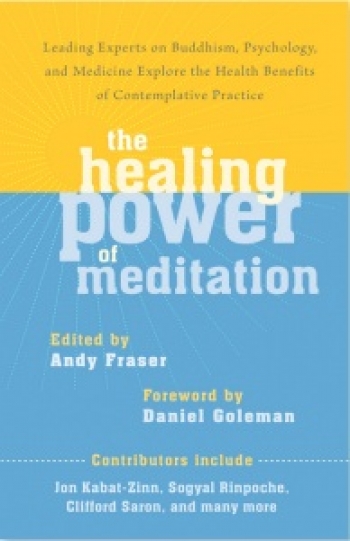Sangeeta Bansal Ph.D, a researcher and writer, is also the founder of a non-profit called Mindside, which aims to make the benefits of mindfulness meditation available to all. Mindside offers an eight-week curriculum that teaches mindfulness practices which have shown to bring about transformative change, from stress reduction, pain management, freedom from addiction and more. The program is offered to all age groups and all religious backgrounds. She can be reached at mindside08@gmail.com.
Introduction
Introduction
Where does disease originate? One usually assumes it is a matter of malfunctioning cells in your body, caused by heredity or environment and can be cured by paying a visit to the family physician, who will prescribe some medication. But what if the physician suggested a program of regular meditation? Meditation can calm the mind, sure, but can it truly cure the body of disease and pain?
Putting medicine and meditation in the same sentence just a few decades ago was considered sacrilegious - a desecration of science serious enough to have professional consequences for medical practitioners. This is ironic as they come from the same Latin root mederie – which has several meanings according to the Latin dictionary, and one of them is “to heal”. A scientific approach to providing evidence that meditation cures disease from a grass roots level could convince some skeptics.
Andy Fraser’s “The Healing Power of Meditation” is one such book and brings out much of the research that has been carried out in the last few decades in this area. It is based on the proceedings of the conference on Buddhism and healthcare (www.buddhismandmedicine.org) that was initiated by Sogyal Rinpoche in the year 2002. In this anthology, the best minds in the areas of neuroscience, medicine and Buddhist thought congregate together and present their experience and experiments with meditation.
1. The Spiritual Backdrop
Is there a distinction between mind and body, or they just part of a continuum of consciousness? This is essential to understanding the connection between the two and the implication for wellness.
In the first section of the book, Fraser presents the teachings of the renowned Sogyal Rinpoche and Khandro Rinpoche; they set the spiritual foundations of the scientific research, reminding us that to tame, transform and conquer the mind is the essence of the Buddha’s teachings. An untamed mind leads to intense suffering, and for this reason there is nothing to fear except an untamed mind. Both samsara and nirvana are creations of the mind: the former is the mind turned outward lost in projections, and the latter is the mind turned inward towards its true nature. We get so caught up in the aspect of mind that is composed of thoughts, feelings and emotions that we never pay attention to the most important aspect of the mind, which is pure peace and contentment. Meditation allows us to step away from our own thoughts and disentangle ourselves from the web of stories they create.
Overall we notice that with regular meditation practice, negativity is undone, speed and aggression are pacified, frustration, tension and turbulent emotions are defused, and the unkindness, violence, and harm in us are removed, revealing our inherent “good heart,” the fundamental goodness and kindness that is our true nature. This is why I always say meditation is real “inner disarmament.” (Sogyal Rinpoche, p.17)
Jon Kabat Zinn reiterates, “Your relationship to the interior narrative about your own experience and its meaning can change profoundly.” (p. 106) This has even been tested scientifically by Norman Farb and Zindel Segal at University of Toronto, who found that meditators did less “self-referencing”; in other words, they focused less on the “story of me and what is happening to me” and more on direct somatic experience in the present moment.
Second, Khandro Rinpoche clarifies that meditation is non-dualistic and has no requirements of the paraphernalia of religion or even spirituality, although they may be useful. It is usually the dualistic human mind that seeks to make something else the object of meditation, rather than one’s own inner awareness.
Third, Khandro Rinpoche observes as human beings we divide the world into things we like and don’t like; then spend half our lives chasing things we say we like, and the other half running away from the things we don’t.This is what the Buddha called suffering.
Suffering is not just about blood and tears, death and dying, and impermanence. These are simpler sufferings. The most complex feature of suffering is that we are capable of addressing it but we do not do it, we complain that we do not do it, and we complain some more. This just cannot be justified, especially when we simultaneously claim to be the most brilliant of all species. If this is not suffering, what is? (p.24).
The key to avoiding suffering is to develop equanimity – a non- judgmental acceptance of things as they are. This releases many concomitant negative emotions of desire, craving, stress, jealousy and anger. These are the building blocks of suffering, and they are psychological.
In Buddhist teachings, pain is separate from suffering. One may have physical or mental pain, but need not suffer for a prolonged period – that is a choice. Suffering is the result of emotion and thought being attached to the pain. Suffering happens when we spin our own story around the painful incident, and identify with it. Much of self-healing requires changing our perspective towards the pain, and not attaching too much importance to it.
Thus, to reiterate, the experience of suffering is predominantly a mental phenomenon, and it is something we can volitionally step away from and dis-identify with. This can be accomplished through mental training techniques such as meditation.
2. The Science Behind the Practice: the neuroscience of emotional healing and anti-aging benefits of meditation
Erika Rosenberg, a scientist and a researcher on emotions, elaborates that happiness is “being increasingly okay with whatever happens in life.” She goes into depth on the nature of our emotions - the idea is not to suppress emotion or be immune to it. Emotions only arise for things that matter to us; we are not emotional about things or people that do not matter to us. As such they provide an insight into the aspects of mind that need work. They illuminate our clinginess and our grasping nature. Tarthang Tulku Rinpoche is quoted as saying,
“Emotions show us where to direct our attention. Rather than obscure the path, they can clarify and sharpen it.”
Our untamed responses to “unbidden” emotional triggers are so fast that there seems to be no free will at all. However, Rosenberg breaks down the “emotional process” into the antecedent event or trigger, the appraisaland the response. While emotional people have most of this process on autopilot and react reflexively to events, we can train our minds to become more conscious of these three distinct phases of emotions, allowing for intervention, and thereby changing the trajectory of the response.
Mindfulness helps in that the mind becomes calmer and allows us to see the emotion as it arises, and we realize that we have a variety of options in responding. We are not slaves to our emotions. Emotional regulation gives us freedom and choice in our repertoire of responses to triggers.
From a neuroscientist perspective, Sara Lazar studies the impact on brain structure after many years of meditation, with the help of an MRI scanner. Images revealed that the insula, the temporal pole and the anterior cingulated cortex (which together comprise the paralimbic cortex) were affected during meditation. These are the regions that have been implicated in numerous psychiatric diseases, including anxiety disorders, depression, bipolar disorder, and schizophrenia. Studies also showed that the amygdala (emotional response center) showed decreased activity for meditators, indicating decrease in arousal and increase in a sense of wellbeing. Furthermore, it was found that the amount of gray matter increased in certain regions of the brain, such as the insula and the pre frontal cortex. The insula is one of the regions responsible for integration of senses, emotions and thoughts, while the thickening of the pre-frontal cortex is evidence of anti-aging aspects of meditation. It is commonly known that the cortex thins out as we age. Fifty-year-old meditators had the same cortical thickness as twenty five year olds.
Clifford Saron, a neuroscientist involved in Shamatha Project also found evidence for the anti-aging benefits of meditation. Telomeres are DNA sequences that divide during cell division – as long as they keep dividing we are in the process of mitosis i.e. passing on genetic material from one generation of cells to another. When this information is not passed on, it results in aging. The enzyme telomerase helps to lengthen the telomeres, and keeps them engaged longer in mitosis. The Shamatha Project showed the control group (the non-meditators) had 30 percent less telomerase than the meditators, confirming the anti-aging benefits related to meditation.
3. Meditation and Well Treatment
Fraser’s concluding chapters are a reminder that a sound healthcare system must focus on compassion. Studies have shown that much like the placebo effect, patients recover when they get a sense of being tended to, rather than their counterparts who are treated with medicine and cold detachment. This compassion is especially important for older patients who have fear of death. One of the cornerstones of mindfulness meditation is the natural arising of empathy and compassion towards all sentient beings – a complete understanding of the oneness of creation, of the interconnectedness of humanity.
















